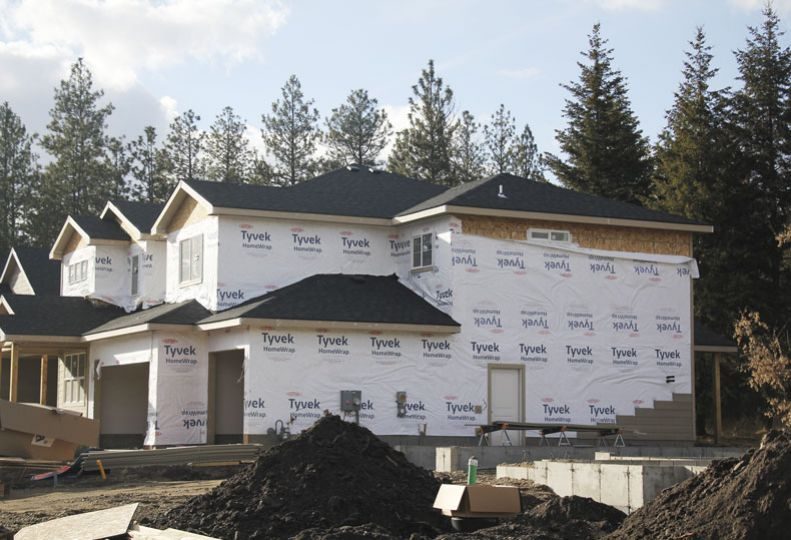
Home » Garden District neighborhood rises on South Hill
Garden District neighborhood rises on South Hill
Single-family houses are being built in $15 million development; multifamily planned at site in future

March 30, 2023
Construction has started on over two dozen single-family homes in Greenstone Corp.’s planned $15 million Garden District community on Spokane’s South Hill.
Jim Frank, founder and CEO of Liberty-Lake-based Greenstone, says about 30 homes are expected to be completed by year-end at Garden District, which is located on 25 acres of land about a half-mile southwest of the Lincoln Heights Shopping Center on 29th Avenue and three blocks west of Spokane Transit Authority’s South Hill Park & Ride, along Southeast Boulevard.
The single-family homes are being constructed along 32nd and 33rd avenues, says Frank.
Greenstone also plans to construct a 75-unit apartment complex with six low-rise, multifamily buildings south of 30th Avenue.
City of Spokane building permit applications are pending for five of the six apartment buildings and show an estimated construction value of $5.5 million. Site plans for the Garden District include a sixth apartment building with 31 units planned on the northeast section of the property.
Frank says Greenstone tries to incorporate economic diversity into each development, including the Garden District, where around 30% of the apartments will have an affordable rental price.
“By affordable, I mean they’ll be priced for people who make less than or around $75,000,” he says.
Construction of the multifamily buildings are planned to begin this summer, and prospective tenants can expect units to be available by next spring, he says.
Greenstone designed the Garden District and will act as the general contractor for the development.
The apartments will include 500- to 600-square-foot studios and 700- to 800-square-foot, one-bedroom units. Two- and three-bedroom apartment units will range in size from 1,000 to 1,200 square feet.
Heidi Bollum, sales manager for Greenstone’s Garden District and a broker for Windermere City Group LLC, says the neighborhood “vibe” will be similar to a smaller-scale Kendall Yards community.
Bollum says, “The whole focus is on getting outside of your homes and interacting with your neighbors on tree-lined streets and a walkway that will go through the green space of the Garden District to encourage that.”
The Garden District will have 7-acres of preserved open space in addition to some public plazas and gathering places.
Frank says, “There’s a native hillside and walking trails there that are being protected, and we built in walking trails and pedestrian trails through the project.”
Bollum notes that, similar to Kendall Yards, she expects sales will be brisk “even without people fully understanding what that neighborhood will be.”
Frank says, “We’re mostly trying to create a walkable neighborhood with protected open space, good pedestrian systems, and access to the Lincoln Heights Shopping Center and the park-and-ride transit (center) on Southeast Boulevard.”
Commercial and mixed-use sites will be developed in the next few years between 29th and 30th avenues, he says.
“That work will probably happen in 2024 or 2025,” Frank says.
Frank says the site was previously owned by Dr. John Sonneland and his family.
“They had their personal family home on the property,” Frank says. “Dr. Sonneland wanted to protect a lot of the land, and he had some ideas for future development that just never happened during his lifetime. The property, after he passed, went into the hands of his children, and they’re trying to follow the legacy that their father had.”
The $15 million value of the Garden District includes the cost of the land, site development, and building construction costs, he says.
Project update:
•Nonprofit children’s home, The Hutton Settlement, has moved its administrative offices to the organization’s 320-acre campus in Spokane Valley, at 9907 E. Wellesley, according to a recent announcement.
Hutton Settlement’s administrative space had been located at 421 W. Riverside, in downtown Spokane.
A newly constructed wing at the Spokane Valley campus, valued at $750,000, added about 1,500 square feet of space for offices and a boardroom.
Chud Wendle, executive director of the organization, previously told the Journal that the nonprofit will realize significant savings by moving the administration to the campus.
Latest News Real Estate & Construction
Related Articles




